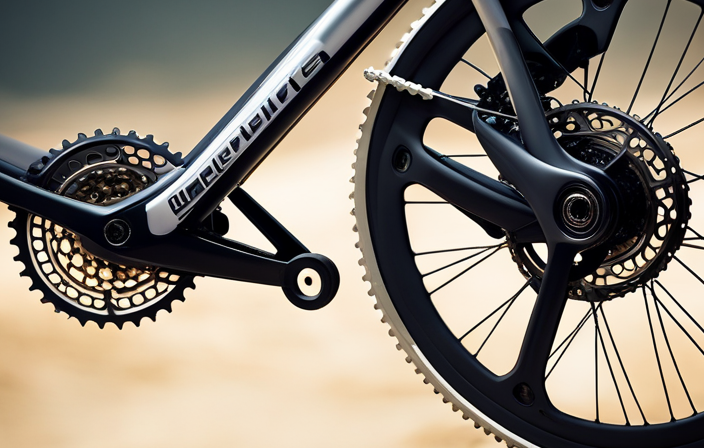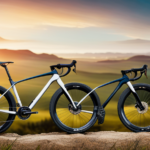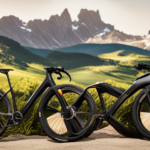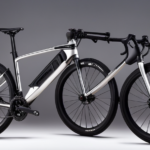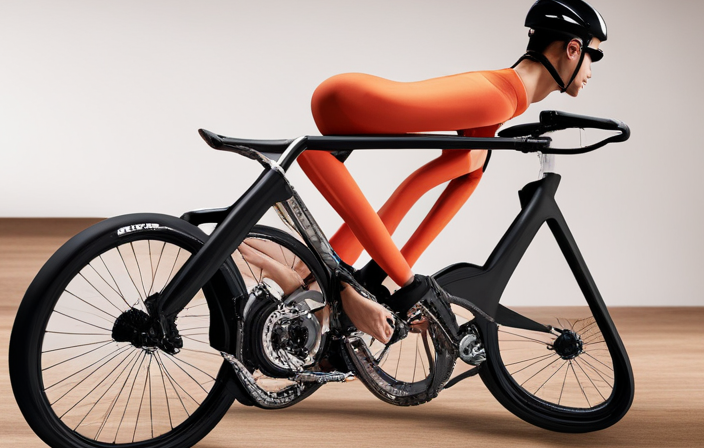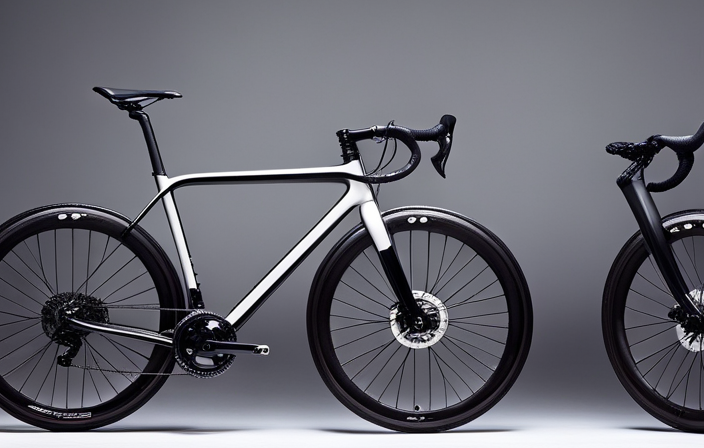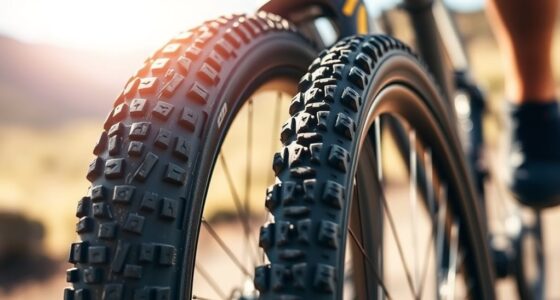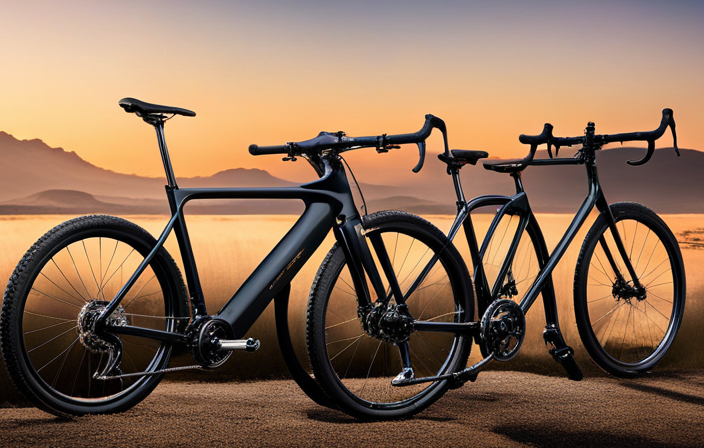Ready to expand your cycling horizons beyond the norm? If you are, then it’s time to dive into the thrilling realm of gravel biking. Discover a new way to ride and explore the great outdoors like never before. Are you up for the challenge?
But before you hit those dirt trails, it’s important to make sure you have the right gear. In this article, I will reveal the top bike gear essentials for conquering gravel terrain with confidence and ease.
From choosing the perfect bike frame to investing in quality suspension forks, we’ll cover everything you need to know.
So strap on your helmet and get ready for an exhilarating ride!
Key Takeaways
- Choose a gravel-specific bike with relaxed geometry and increased tire clearance.
- Opt for wide tires and lower tire pressure for better traction and stability.
- Use tubeless tires to reduce the risk of punctures and increase stability.
- Invest in lightweight and durable components, such as carbon fiber or titanium, to enhance speed and efficiency.
Choose the Right Bike Frame
The right bike frame for gravel riding depends on personal preferences and the type of terrain you plan to tackle. When it comes to bike frame materials, there are several options to consider.
Aluminum frames are lightweight and affordable, making them a popular choice for gravel bikes. They offer a good balance between durability and comfort, making them suitable for various terrains.
On the other hand, carbon fiber frames provide excellent vibration dampening properties, ensuring a smoother ride on bumpy gravel roads. They are also lighter than aluminum frames, which can enhance your overall performance.
In addition to materials, bike frame geometry plays a crucial role in gravel riding. Gravel-specific frames typically feature more relaxed geometry compared to road bikes. This means a longer wheelbase and slacker head tube angle, providing stability and confidence when tackling rough terrain.
The increased tire clearance allows you to fit wider tires for better traction over loose surfaces.
When choosing the right bike frame for gravel riding, it’s important to consider both the material and geometry that best suits your needs. Once you have found the perfect frame, you can then opt for wide tires for better traction as you venture into different types of terrain without compromising comfort or control.
Opt for Wide Tires for Better Traction
Opting for wide tires on gravel bikes provides better traction. When riding on gravel surfaces, maintaining control and stability is crucial, and having wider tires can greatly enhance your riding experience. One of the key benefits of wider tires is that they allow you to run lower tire pressure. By reducing the tire pressure, the larger contact patch with the ground increases grip and traction, especially on loose gravel terrain.
Lowering the tire pressure also helps absorb vibrations and impacts, providing a smoother ride over rough surfaces. This not only improves comfort but also reduces fatigue during long rides. Additionally, wider tires offer improved stability by distributing your weight more evenly across the surface area, minimizing the risk of sliding or losing control.
It’s important to note that when opting for wider tires, you should consider factors such as frame clearance and compatibility with your bike. Checking the maximum recommended tire width by your bike manufacturer is essential to ensure a proper fit.
Considering these benefits, it becomes evident why opting for wide tires is an excellent choice for enhancing traction and overall performance on gravel surfaces. However, there are other aspects to consider when choosing a suitable bike for gravel riding such as considering a gravel-specific bike that offers additional features tailored specifically for this type of terrain.
Consider a Gravel-Specific Bike
When considering your options, it’s important to think about a bike specifically designed for riding on gravel terrain. A gravel-specific bike offers several advantages that can greatly enhance your riding experience.
Here are four reasons why you should consider investing in a gravel-specific bike:
-
Bike Fit: Gravel bikes are designed with longer wheelbases and relaxed geometry, providing a more stable and comfortable ride on uneven surfaces. This ensures better control and minimizes fatigue during long rides.
-
Bike Handling Techniques: Gravel bikes come equipped with wider handlebars, allowing for better leverage and control when navigating tricky sections of the trail. This enhanced handling capability gives you the confidence to take on challenging terrains.
-
Tire Clearance: Gravel-specific bikes have wider tire clearance compared to traditional road bikes. This allows you to use wider tires with lower air pressure, resulting in increased traction and stability on loose gravel surfaces.
-
Frame Durability: Gravel bikes feature robust frames made from materials like steel or carbon fiber, ensuring they can withstand the rigors of off-road riding while maintaining optimal performance.
Considering these factors, investing in a quality suspension fork can further enhance your gravel biking experience by providing added comfort and control over rough terrain without compromising speed or efficiency.
Transitioning into the subsequent section about ‘invest in a quality suspension fork,’ it is crucial to explore additional components that contribute to an ideal setup for gravel riding.
Invest in a Quality Suspension Fork
Consider upgrading your bike with a quality suspension fork for improved comfort and control on rough terrain. When it comes to gravel biking, having the right suspension setup can make a significant difference in your ride experience.
While some riders may prefer a rigid fork for its simplicity and efficiency, a suspension fork offers several benefits that can greatly enhance your gravel riding.
One of the main advantages of a suspension fork is its ability to absorb impacts from uneven surfaces. Gravel roads can be filled with bumps, rocks, and other obstacles that can jolt your bike and make it harder to maintain control. A good suspension fork helps to smoothen out these rough sections, providing you with a more comfortable and stable ride.
Moreover, different terrains require different levels of suspension setup. With a quality suspension fork, you have the flexibility to adjust the settings according to the type of terrain you are riding on. Whether you’re tackling loose gravel or tackling steep descents, being able to fine-tune your suspension can greatly improve traction and handling.
With proper suspension setup, you’ll have more confidence in navigating challenging gravel paths.
The next step towards maximizing your performance is by using tubeless tires for reduced puncture risk…
Use Tubeless Tires for Reduced Puncture Risk
To reduce the risk of punctures, try using tubeless tires on your bike. Tubeless tires have become increasingly popular among gravel cyclists for several reasons.
First, they provide reduced rolling resistance compared to traditional tubed tires. This means that you can maintain a higher speed with less effort, allowing you to cover more ground and conquer challenging terrain more easily.
In addition to reduced rolling resistance, tubeless tires also offer the benefit of being able to run lower tire pressures. By lowering the tire pressure, you increase the contact patch between the tire and the ground, improving traction and control. This is especially important when riding on rough and unpredictable surfaces like gravel.
Furthermore, tubeless tires are less prone to flats caused by thorns or sharp rocks. Since there is no inner tube to puncture, you can ride with confidence knowing that your chances of getting a flat are significantly reduced.
Overall, using tubeless tires on your bike provides several advantages: reduced rolling resistance, improved traction at lower tire pressures, and decreased risk of punctures. These benefits make them an excellent choice for gravel cycling where stability and reliability are crucial.
When transitioning into selecting the right gearing for climbing and descending on gravel trails or roads without writing ‘step’, it’s essential to consider how different gear ratios can optimize your performance in varying terrains.
Select the Right Gearing for Climbing and Descending
Selecting the right gearing for climbing and descending on gravel trails or roads is crucial for optimizing performance in varying terrains. When it comes to gravel riding, gear ratio selection plays a significant role in helping you conquer steep inclines and navigate fast descents with ease.
To achieve gearing optimization, it is essential to understand the terrain you will be riding on and choose appropriate gears accordingly.
For climbing, having lower gears can make a huge difference in your ability to power up steep hills without exerting excessive energy. This means opting for a smaller chainring upfront and a larger cassette at the rear. This combination allows for easier pedaling and keeps your legs fresh during demanding climbs.
On the other hand, when descending, higher gears are preferred as they allow you to maintain speed while pedaling efficiently. A bigger chainring upfront coupled with a smaller cassette at the rear provides more resistance and enables faster cadence without spinning out.
By selecting the right gears for both climbing and descending, you can optimize your performance on gravel trails or roads. This ensures that you have the necessary power to tackle challenging ascents while maintaining control during speedy descents.
Transitioning into the subsequent section about getting a comfortable and durable saddle, proper gear selection sets the foundation for an enjoyable ride experience on any terrain.
Get a Comfortable and Durable Saddle
Find a saddle that provides both comfort and durability for your rides.
When it comes to gravel biking, having the right bike seat is crucial for a comfortable and enjoyable experience on rough terrains. There are various bike seat options available in the market, ranging from cushioned saddles to those with cutouts or gel padding. It’s important to find the right saddle fit that suits your body type and riding style.
Firstly, consider the width of the saddle. A wider saddle can provide more support for your sit bones during long rides, while a narrower one allows for easier pedaling and maneuverability. Additionally, look for a saddle with adequate padding that absorbs shocks and vibrations from uneven surfaces.
Durability is another key factor when choosing a saddle for gravel biking. Opt for materials like leather or synthetic leather that can withstand rough conditions without wearing out quickly.
Incorporating these features into your choice of bike seat will ensure optimal comfort and longevity on your gravel adventures.
Moving forward, let’s explore how using grippy handlebar tape can enhance control over your bike without compromising comfort.
Use Grippy Handlebar Tape for Better Control
Improve your control over the handlebars by using grippy handlebar tape. One of the most important factors when riding on gravel is maintaining a firm grip on the handlebars, especially when encountering rough terrain or unexpected obstacles. Grippy handlebar tape enhances your grip strength and provides a more secure hold, allowing you to confidently maneuver through any challenging conditions.
When choosing handlebar tape, it’s crucial to consider its durability. Gravel riding can be demanding on equipment, with vibrations and constant jostling affecting the longevity of your gear. Opt for tape that is specifically designed for off-road riding, as it tends to be more durable and resistant to wear and tear.
In addition to providing better control and durability, grippy handlebar tape also offers increased comfort during long rides. The textured surface helps reduce hand fatigue by minimizing slippage and absorbing shock from uneven terrain. This allows you to maintain a relaxed grip while still having complete control over your bike.
Investing in high-quality grippy handlebar tape is an essential step towards optimizing your gravel riding experience. By ensuring a secure grip and enhanced comfort, it sets the foundation for a more enjoyable ride.
To further enhance your performance on gravel trails, let’s explore how investing in a good pair of cycling shoes can make a significant difference in your overall riding experience.
Invest in a Good Pair of Cycling Shoes
After discussing the importance of using grippy handlebar tape for better control on gravel, let’s now shift our attention to another essential gear: cycling shoes.
As a passionate cyclist, I can attest that investing in a good pair of cycling shoes makes a world of difference in both performance and comfort.
When it comes to choosing the right cycling shoe, there are several features to consider. Firstly, opt for a shoe with a stiff sole, as this helps transfer power efficiently from your legs to the pedals. Additionally, look for shoes with adjustable closures, such as straps or BOA dials, which allow for a secure and customized fit.
One of the greatest benefits of investing in clipless pedals is enhanced pedaling efficiency. Clipless pedal systems enable you to attach your cycling shoes directly to the pedals using cleats. This connection ensures that every ounce of energy you exert is transmitted into forward motion without wasting any through slippage.
Moving forward into our next topic on wearing moisture-wicking and breathable clothing, it’s important to consider how these elements play a crucial role in enhancing your overall biking experience.
Wear Moisture-Wicking and Breathable Clothing
Moisture-wicking and breathable clothing is essential for enhancing your overall biking experience. When choosing the right fabric, consider materials such as polyester or nylon that have moisture-wicking properties to keep you dry and comfortable during your gravel rides. These fabrics are designed to pull sweat away from your skin and evaporate it quickly, preventing that clammy feeling that can occur with other types of clothing.
Proper fit is also crucial when it comes to cycling apparel. Opt for a snug but not too tight fit that allows freedom of movement while minimizing any excess fabric flapping in the wind. Layering is important for all weather conditions – start with a lightweight base layer, add a jersey or jacket depending on the temperature, and finish off with a windproof outer layer if necessary.
In addition to clothing, selecting the right cycling shoes for gravel riding is essential. Look for shoes that offer good traction on both pedals and off-road surfaces, as well as enough stiffness for efficient power transfer.
For temperature control, arm and leg warmers can be useful accessories. They can easily be added or removed during the ride as needed to regulate body temperature.
To further enhance comfort and grip while riding on gravel terrain, consider using cycling gloves. They provide extra padding and protection against vibrations from rough surfaces while also offering improved grip on handlebars.
Transitioning into the subsequent section about using cycling gloves for extra comfort and grip: "In addition to wearing moisture-wicking clothing, don’t forget about the importance of using cycling gloves for extra comfort and grip."
Use Cycling Gloves for Extra Comfort and Grip
When riding on gravel, it’s important to have the right gear to ensure a comfortable and safe experience. In my previous subtopic, I discussed the importance of wearing moisture-wicking and breathable clothing. Now, let’s talk about another essential gear for gravel riding: cycling gloves.
Cycling gloves offer numerous benefits that can greatly enhance your ride. Firstly, they provide extra comfort by cushioning your palms and reducing pressure points that can cause discomfort during long rides. They also offer a better grip on the handlebars, especially when navigating rough terrain or tackling challenging climbs.
To reap these benefits, it’s crucial to choose the right size gloves. Ill-fitting gloves can be uncomfortable and restrict hand movements. When selecting cycling gloves, make sure they fit snugly without being too tight or loose. Look for options with adjustable straps or closures that allow you to customize the fit according to your preference.
Now that we’ve covered the importance of cycling gloves for gravel riding, let’s move on to the next section where we’ll discuss how to carry the essentials in a lightweight backpack or saddlebag. This ensures you have everything you need without compromising your comfort or maneuverability on the bike.
Carry the Essentials in a Lightweight Backpack or Saddlebag
Carrying the essentials in a lightweight backpack or saddlebag is important to ensure you have what you need without compromising comfort or maneuverability on your ride. When it comes to choosing between a lightweight backpack and a saddlebag, both options have their pros and cons.
Here are four essential items for gravel riding that can easily be carried in either:
-
Water bottle: Staying hydrated is crucial during any ride, especially on long gravel rides where water sources may be scarce.
-
Spare tube and tire levers: Flat tires are never fun, but they’re even less enjoyable when you’re far away from civilization. Having a spare tube and tire levers can save you from being stranded.
-
Multi-tool: Gravel riding often takes you off the beaten path, so having a multi-tool handy can help with any unexpected mechanical issues that may arise.
-
Snacks: Fueling your body with energy-packed snacks like energy bars or gels is essential for maintaining stamina during long rides.
Both backpacks and saddlebags have their advantages; backpacks offer more storage space and distribute weight evenly across your back, while saddlebags keep the weight low and don’t interfere with your body movement as much. Whichever option you choose, make sure it’s comfortable and secure before hitting the gravel trails.
To further enhance your gravel riding experience, consider installing fenders to protect yourself from mud and dirt kicked up by your tires.
Install Fenders to Protect Yourself from Mud and Dirt
To enhance your gravel riding experience, you should consider installing fenders on your bike to protect yourself from mud and dirt. Installing mudguards is a simple yet effective way to keep yourself clean and comfortable while riding on gravel roads.
Using fenders has several benefits. Firstly, they prevent mud and dirt from splashing up onto your clothes, face, and bike components. This not only keeps you cleaner but also helps to extend the lifespan of your bike by reducing the amount of grit that can get into delicate parts like the drivetrain or brakes. Secondly, fenders also provide some protection against water spray when riding in wet conditions. They help to keep you drier and more comfortable during rainy rides.
Here’s a table highlighting some key advantages of using fenders:
| Benefits of Using Fenders |
|---|
| Keeps you clean |
| Protects bike components |
| Reduces wear and tear |
| Provides comfort |
By installing fenders, you can enjoy your gravel rides without worrying about getting covered in mud or damaging your bike. Now that we’ve covered how to protect yourself from dirt and mud, let’s move on to the next section where we will discuss considering a bike computer or GPS for navigation purposes.
Consider a Bike Computer or GPS for Navigation
When it comes to riding on gravel, installing fenders is a great way to protect yourself from mud and dirt. However, there’s another important accessory that can greatly enhance your gravel riding experience: a bike computer or GPS for navigation.
Having a bike computer or GPS provides several benefits. Firstly, it allows you to track important data such as distance, speed, and elevation gain, giving you valuable insights into your performance. This information can help you set goals and monitor your progress over time.
Secondly, a bike computer or GPS can provide turn-by-turn directions, ensuring that you never get lost on unfamiliar gravel roads. This is especially useful when exploring new routes or participating in organized gravel rides.
Lastly, these devices often come with mapping features that allow you to plan out your ride in advance. You can create custom routes based on your desired distance and terrain preferences, making it easier to discover new scenic paths.
In summary, investing in a bike computer or GPS for navigation is highly beneficial for gravel riding. It helps track important data, provides turn-by-turn directions, and allows for easy route planning. With these tools by your side, you’ll have more confidence exploring the beautiful world of gravel riding.
And remember: don’t forget to bring water and snacks for longer rides!
Don’t Forget to Bring Water and Snacks for Longer Rides
Make sure to pack water and snacks for longer rides, as staying hydrated and fueled is essential for a successful gravel ride.
When you’re out on the trails, it’s important to stay hydrated to maintain your energy levels and prevent fatigue. One of the best hydration tips I can give you is to bring a portable water bottle or hydration pack that you can easily access while riding. This way, you can take sips of water whenever you need to without having to stop and unpack your bag.
In addition to water, packing portable snacks is also crucial for longer rides. These snacks should provide a good balance of carbohydrates, protein, and fats to keep you energized throughout your ride. Some great options include energy bars, trail mix, dried fruits, nuts, or even sandwiches if you have room in your bag.
It’s important to choose snacks that are easy to eat while riding and won’t weigh you down. Avoid bringing heavy or messy foods that could be difficult to handle on rough terrain. And don’t forget about portion control – bring enough food for the duration of your ride but try not to overpack.
By following these hydration tips and packing portable snacks for longer gravel rides, you’ll be able to fuel yourself properly and stay energized throughout your adventure.
So next time you head out onto the trails, make sure your backpack is stocked with plenty of water and tasty treats!
Frequently Asked Questions
Can I use a regular road bike for gravel riding?
Yes, you can use a regular road bike for gravel riding, but it has its limitations.
Road bikes are designed for smooth pavement and may struggle on rough terrain.
Gravel bikes, on the other hand, are specifically built to handle the challenges of off-road riding.
They have wider tires for better traction and stability, more relaxed geometry for comfort, and often come with added features like disc brakes and clearance for larger tires.
Overall, a gravel bike offers greater versatility and performance on gravel surfaces compared to a road bike.
How do I know if I need a suspension fork for gravel riding?
If you’re wondering whether you need a suspension fork for gravel riding, it depends on your personal preferences and the type of terrain you’ll be encountering.
A suspension fork can provide added comfort and control by absorbing shocks and bumps.
However, a rigid fork has its own benefits, including better power transfer and increased efficiency.
Ultimately, it’s important to consider your riding style and the specific conditions you’ll be riding in before deciding on a suspension or rigid fork.
What type of tires should I choose for gravel riding?
When it comes to choosing tires for gravel riding, it’s like finding the perfect pair of shoes for a hike. You want something that provides good traction and stability, but also offers comfort and durability.
Opt for wider tires with a tread pattern designed for off-road conditions. As for tire pressure, slightly lower pressures work better on gravel to improve grip and cushion the ride.
Remember, finding the right tires can make all the difference in your gravel riding experience!
Do I need to wear specific shoes for gravel riding?
For gravel riding, it’s recommended to wear specific shoes designed for this type of terrain. There are several gravel riding shoe brands available in the market that offer features tailored for off-road adventures.
These shoes typically have a stiffer sole for efficient power transfer and better pedaling performance. They also have increased durability, enhanced grip, and often feature protective elements like reinforced toe boxes and ankle support.
Overall, investing in a good pair of gravel riding shoes can greatly improve your comfort and performance on the trails.
What are the essential items I should carry in my backpack or saddlebag for gravel rides?
When it comes to gravel rides, there are a few essential items that I always make sure to carry in my backpack or saddlebag.
First and foremost, a spare tube and tire levers are crucial in case of a flat tire.
Additionally, a multi-tool with various sizes of Allen keys is handy for any necessary adjustments.
I also recommend carrying a mini pump or CO2 inflator.
Lastly, don’t forget to pack some snacks, water, and a first aid kit for emergencies.
Conclusion
As I pedal through the gravel, my mind is filled with excitement and anticipation. The right bike gear can make all the difference in this adventurous terrain.
From choosing the perfect frame to investing in quality suspension, every decision counts. Wide tires provide better traction, while tubeless tires reduce the risk of punctures. Carrying essentials in a lightweight backpack or saddlebag ensures preparedness. And don’t forget about installing fenders for protection from mud and dirt.
With navigation tools and refreshments in tow, I embark on these thrilling rides with confidence and determination. The gravel awaits, ready to challenge me at every turn.
